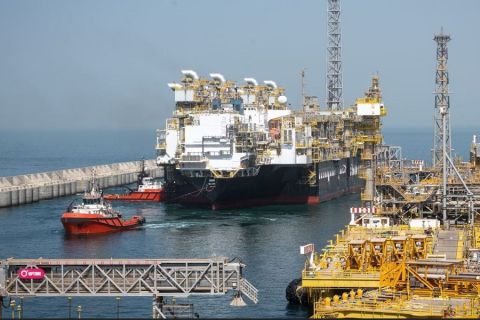The Marcellus and Utica unconventional plays are big and getting bigger by the day. That’s good news, but the Appalachian region presents a host of midstream challenges right now. Given that contrasting backdrop, it’s easy to see why Hart Energy’s 7th Marcellus-Utica Midstream Conference & Exhibition in Pittsburgh drew a strong turnout.
Donald Raikes, senior vice president for customer service and business development at Virginia-based Dominion Energy, gave the opening keynote and assured the large crowd “help is on the way” for the challenged region, as well as the energy industry.
He had some simple advice for anyone pondering the state of today’s oil and gas market as it treads what is increasingly being recognized as an unprecedented downturn.
“If you think you’ve figured it out, you haven’t,” he told the conference.
But one thing he did emphatically state during the opening keynote at the David L. Lawrence Convention Center was that the industry “is in tough times, but there will be a turnaround.” And what a place to be when it happens, he emphasized.
Thirst for gas
The Marcellus-Utica region lies a stone’s throw away from large East Coast markets. And that’s good news for midstream companies. “The East Coast has a new thirst for natural gas,” Raikes said, using the lyrics of a hit song from the ’70s rockers Little River Band to illustrate his point: “hang on, help is on the way.”
That help is largely in the form of new pipelines and LNG exports. “We need new markets to satisfy the oversupply,” Raikes said.
Markets are starting to show signs of catching up despite the backlog of production. From 2014 to 2016, the Northeast’s daily gas demand will grow 2.5 billion cubic feet (Bcf), most of it for power generation. And Raikes pointed out that there is a “dramatic effort to unburden the gas bubble in the Northeast.”
Markets are starting to show signs of catching up despite the backlog of production. From 2014 to 2016, the Northeast’s daily gas demand will grow 2.5 billion cubic feet (Bcf), most of it for power generation. And Raikes pointed out that there is a “dramatic effort to unburden the gas bubble in the Northeast.”
Pipeline projects and LNG exports yielded about 3 billion cubic feet per day (Bcf/d) from projects put online last year. This year, there is another 4.7 Bcf/d, and between now and 2018, there could be still more.
The Atlantic Coast Pipeline Project aims to better supply the East Coast with gas. Dominion joined Duke Energy and Piedmont Natural Gas and began work on a 550-mile pipeline project out of the Marcellus-Utica’s heart. It is mostly 42-inch pipe, already has 20-year agreements and has secured between $4 billion and $5 billion of investments.
“The driver of the project is the need for diverse and low-cost natural gas in the Northeast,” Raikes said. He added the design is near completion and procurement is 60% completed.
The opposition
He said the project does face some environmental opposition. “They want to kill natural gas like they killed coal,” Raikes said, but pointed out that the pipeline means a $500 million-a-year benefit to the area.
Raikes said the second driver for the future is LNG exports. Dominion’s Cove Point LNG facility in Lusby, Md., is one of the facilities at the forefront of the movement and offers a significant piece of infrastructure for the East Coast.
The project will cost $3.4 billion to $3.8 billion and is expected to be in service in late 2017. LNG exports help open up new markets for Marcellus-Utica gas, Raikes said, and the project is 56% complete.
“A lot of people ask, ‘Is it worth it to export LNG?’ The answer is ‘yes,’” Raikes said. “Our customers told us that when they heard they could have LNG sourced from ‘Saudi America’ as they call us, it immediately helped their over-all portfolios and gave them leverage in negotiating with other countries for contracts and renewals.”
Pipeline price
One presentation focused on the increasing, long-term demand for Appalachian gas that will require construction of the largest pipeline in the continental U.S., one that would reach from the western edge of the Marcellus Shale to a hub in the south. Footing the cost for the $9 billion to $12 billion project in a downcycle is where things get complicated, according to market specialist Rick Notarianni of McKinsey & Co.
But deferring construction of the line could cost the industry as much as $70 billion, Notarianni warned.
“A lot of the easy stuff is done already,” Notarianni said, explaining that reversing lines and building out intraregional pipes are easier to finance. The forecast for increased demand in the next 10 years necessitates an additional 18 Bcf/d of production from the Marcellus and Utica.
“Demand growth is now almost exclusively cut off from supply growth,” he said. Those pipeline reversals, Cove Point and new pipelines will cover most of the additional production, but that still leaves a shortfall of 2.5 Bcf/d to 2.7 Bcf/d. Moving that much gas out of the region would require a 900-mile, 48-inch pipeline—as big as the giant Trans-Alaska Pipeline System.
The alternative to building the pipeline would be to drill for gas elsewhere.
“If you can’t drill wells in the Marcellus or the Utica, you’re going to have to go somewhere else to meet demand, and that somewhere else is going to be the Haynesville, that somewhere else is going to be the Piceance, the Uinta basin out in the Rockies,” Notarianni said. “Those wells cost more and they’re less efficient, so you’ll have to drill more, so more money needs to be pumped in. Over the next 10 years, that’s almost $70 billion of unoptimal spending because you can’t drill where you should in the Marcellus and the Utica.”
McKinsey doubts the needed pipeline will be built in the short term. Long term, however, rising demand will force the industry to revisit the issue, he said.
“If we want to continue growing this basin at the pace that it should be grown,” he asked, “are we prepared to make the big investments over the next few years to allow it to grow in the long term?”
MPLX/MarkWest
The big Appalachian plays have changed not just midstream geography but the structure of midstream players. A highlight of the wide-ranging conference program was a review of one of the biggest M&A deals of last year—the acquisition by Marathon Petroleum’s MPLX unit of MarkWest Energy Partners. Both are major Appalachian midstream players and combined have created one new and larger firm that can grow by employing the assets of both, according to two executives.
Craig Pierson, president of Marathon Pipe Line LLC, pointed to “the significant opportunities in front of us” as he began his review of the merger. “We have opportunities to serve the market across the entire hydrocarbon value chain” by joining adjacent assets.
Pierson said he sees an “efficient overlap” of the two firms—including a major presence in the Marcellus and Utica midstream—“that will enable us to serve the market in the most efficient way.” MPLX, he reminded the audience, began in 2012 “with a very strong sponsor in Marathon Petroleum,” which has substantial midstream assets that support its refining and market operations, creating important dropdown opportunities.
Added to those Marathon assets now, “MarkWest is a premier gatherer, processor and fractionator, with assets that are very close to some of ours,” he said. “We have a great organic growth backlog and not just in local markets, that will hopefully improve producers’ netbacks.”
He cited as an example the advantages of integrating MarkWest’s Utica gathering and processing assets centered in Canton, Ohio, which fit well with Marathon’s refinery at Catlettsburg, Ky. Adding to the combined operation, the new 50-mile, 16-inch Cornerstone Pipeline will move condensate and natural gasoline for Utica producers. Work is on schedule “and by this time next year we will have a couple months of operations under our belt,” he said.
Refinery connections
Looking to 2017 and beyond, Pierson added MPLX plans pipeline projects that will move Utica production west to its refineries at Lima and Toledo, Ohio, and other Midwestern downstream markets.
“When the industry does rebound, we will be there with a lot of growth potential,” Pierson said of the expansion.
Scott Garner, vice president of corporate development and joint-venture management at MarkWest, discussed the business strategy set following the MPLX/MarkWest combination.
Garner said there are “a number of combination synergies that we will draw on. There are opportunities now that we did not draw on in the past.” He also emphasized MPLX/MarkWest will focus on connecting production from high-performance resource plays, such as the Marcellus and Utica, to both global and U.S. downstream markets.
MarkWest is the major gathering and processing player already in the Marcellus and Utica, Garner said. He added the firm handles three-quarters of the rich-gas production from the Marcellus and Utica with some 8 million producer acres dedicated to its midstream system.
Leveraging on the combined processing and refining assets of the firm, Garner said MarkWest is working to upgrade butane produced in Appalachia into alkylate, a high-octane gasoline blendstock.
“Alkylate is an ideal gasoline blending component that will become increasingly valuable with pending fuel regulations,” he said, adding the goal is to “develop Mont Belvieu-like capabilities in the Northeast,” referring to the sprawling NGL fractionation, transportation and storage hub outside Houston.
‘Vast potential’
Mark Mitchell, senior vice president with Crestwood Equity Partners LP, emphasized the potential of the region in his presentation, adding the Northeast Marcellus represents a “world-class resource base with vast potential.” But current oversupplied market conditions pose significant challenges for some midstream operators, he cautioned.
Crestwood operates several storage and transportation assets in the Northeast Marcellus, including a storage facility “sitting right on the top of the core of the dry Marcellus,” called the Stagecoach facility, according to Mitchell. The facility can store 21.4 Bcf of working gas and interconnects with Millenium Pipeline, Tennessee Gas Pipeline and Transco Pipeline. Other storage assets include its Steuben and Thomas Corners facilities.
Working with its Stagecoach facility, Crestwood has in five years developed a significant transportation business focused on providing delivery alternatives for Marcellus producers, Mitchell said. Today, it has four major receipt points on its system that are directly connected to upstream gathering facilities. Until recently, this resulted in 1.1 Bcf/d to 1.4 Bcf/d of direct supply feeding into the system, which moved downstream to pipelines.
Price degradation
“The tremendous growth in production, together with a lack of takeaway capacity, have led to significant basis degradation,” said Mitchell. “Over the last five years, we’ve seen a pretty steady degradation of the pricing spread on the summer-winter strip.”
Part of the problem, according to Mitchell, is the time lag needed for demand to catch up with supply.
“Today we’re facing some pretty significant headwinds,” he said. “We’ve got this tremendous growth taking place. The demand always takes longer. The supply can react so fast.”
In a move to incentivize buyers and seller to transact more in the basin, Crestwood launched a new contract on the Intercontinental Exchange in fourth-quarter 2015. One feature is access to the Stagecoach hub is available at no cost.
The Canadian market
One of the biggest markets for Marcellus and Utica gas liquids lies to the north—and Canada is making good use of that abundant NGL production, according to John Hotz, vice president of corporate strategy for NOVA Chemicals Corp., which has a sprawling petrochemical operation in Sarnia, Ontario.
NOVA has seen its Sarnia operations do a U-turn from concerns over closure to considerable expansion, thanks to the Marcellus and Utica.
“Going back to 2005, we were concerned whether it had a life beyond 2010,” Holtz said. “The Marcellus and Utica have really been a lifesaver for us in Sarnia.”
Its naphtha cracker was revamped to NGLs and the plant’s feed slate is now 70% ethane—sourced from the Marcellus. In December, NOVA received approval to convert it to 100% ethane by 2018. In conjunction, the company is planning to debottleneck the cracker by doubling it by 50% and is considering building another plant. This will continue with NOVA converting the plant to 100% ethane in 2018.
Hotz added that the facility has the potential to expand capacity by 50% in 2022.
It’s different here
Midstream operators moving into Appalachia find the region is fundamentally different, according to Kevin Hyatt, vice president for commercial and business development for EnLink Midstream LLC.
The Dallas-based firm found the two plays require diverse midstream services after it entered the market in 2012 and EnLink has responded because it “anticipates continued growth in the Appalachian Basin,” Hyatt said.
Hyatt told attendees some of EnLink’s liquids-handling assets in Appalachia and along the Ohio River have been in place since the 1870s. John D. Rockefeller’s Standard Oil made Cleveland a refining center in the 19th century when Standard needed a midstream component of pipelines, railroads and barges to gather, store and process Pennsylvania-grade crude.
“It all begins with our truck fleet, also known as a pipeline on wheels,” Hyatt said, noting EnLink trucks serve more than 100 producers in the core Marcellus-Utica states of Pennsylvania, Ohio and West Virginia, as well as Kentucky and Tennessee. “Those customers have over 10,000 tanks that hold crude, brine and condensate.”
To serve them, EnLink now has more than 110 trucks, 200 miles of crude oil pipeline, 700,000 bbl of storage, a barge terminal on the Ohio River, a rail terminal in Ohio, seven gas compressors and crude stabilizers and eight brine disposal wells.
“Our barges move production up and down the Ohio River, going as far south as the Louisiana Gulf Coast. Our rail customers go as far as Canada and eastern refiners along the Atlantic Coast,” Hyatt said.
Time in New England
A key to opening hoped-for demand lies in New England, which is underserved by the U.S. gas pipeline grid.
As a result, New Englanders pay about 65% more than the rest of the country for electricity and about 40% more for gas, according to Robin Rorick, group director of midstream and industry operations at the American Petroleum Institute (API).
“It’s shocking to me that there is all of this gas here in the Utica and Marcellus that can be used in the New England area where they need it—and they are using a lot more as gas is replacing heating oil—but because of a lack of infrastructure, New Englanders pay significantly more for their energy,” he said at the conference’s closing keynote.
But New England isn’t alone when it comes to being put at a disadvantage due to a lack of energy infrastructure. Rorick said that there is an essential need for the development of broad infrastructure nationwide.
“There’s still going to be a continuance of the energy renaissance in this country,” Rorick said. “[API] supports broad infrastructure development.”
He said that there is government support for broad infrastructure; however, policies don’t always back up any verbal shows of support.
One of the biggest challenges is that there is largely a lack of knowledge from the general public that there is a network of transmission underground. “People don’t care about pipelines when they do what they are supposed to do. It’s when there is an incident that they notice,” he said.
And that perception leads to difficulties in getting permitting and investment.
“There are projects held up by counties or even individuals in a state that affect permits,” he said. “Often, they are people who don’t understand pipelines. So the industry needs to engage with communities.”
Recommended Reading
TotalEnergies Starts Production at Akpo West Offshore Nigeria
2024-02-07 - Subsea tieback expected to add 14,000 bbl/d of condensate by mid-year, and up to 4 MMcm/d of gas by 2028.
Sangomar FPSO Arrives Offshore Senegal
2024-02-13 - Woodside’s Sangomar Field on track to start production in mid-2024.
BP: Gimi FLNG Vessel Arrival Marks GTA Project Milestone
2024-02-15 - The BP-operated Greater Tortue Ahmeyim project on the Mauritania and Senegal maritime border is expected to produce 2.3 million tonnes per annum during it’s initial phase.
Exxon Mobil Green-lights $12.7B Whiptail Project Offshore Guyana
2024-04-12 - Exxon Mobil’s sixth development in the Stabroek Block will add 250,000 bbl/d capacity when it starts production in 2027.
E&P Highlights: April 1, 2024
2024-04-01 - Here’s a roundup of the latest E&P headlines, including new contract awards.





